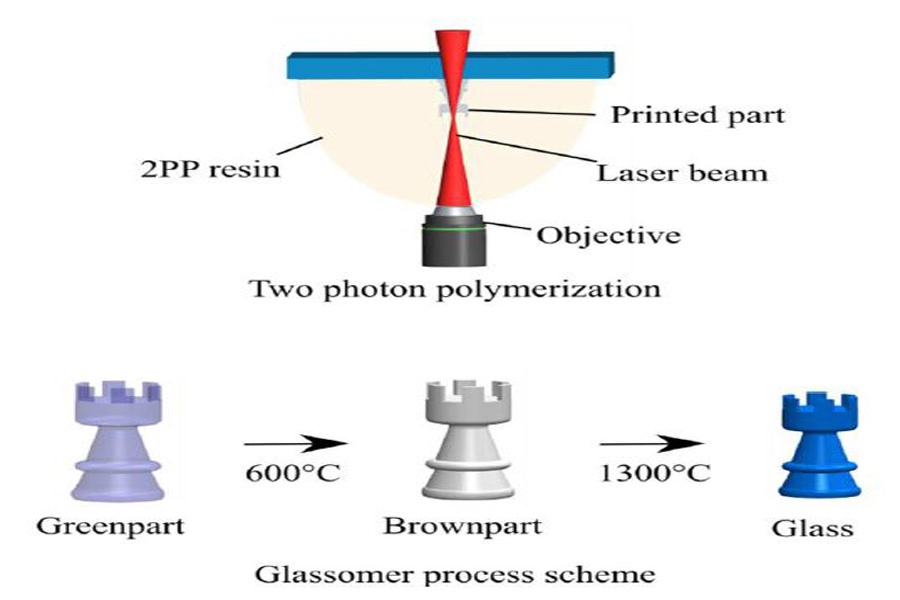
For the next generation of photonics, sensing and imaging technologies, the function of 3D printed glass is essential for the development of highly complex, free-form or small-scale structures. However, it turns out that it is difficult to process 3D printed glass. The melting point of the glass exceeds 1400°C while retaining its unique chemical, mechanical and optical properties.
The latest advances not only have successful 3D printed glass with the same characteristics and shapes as commercial glass, but also have further developed specific 3D printing technologies to print glass structures with unprecedented scale and complexity, and have customizable optical properties. One of them is OptoGlass3D, a novel method of 3D printing glass developed by Glassomer GmbH and Nanoscribe GmbH, led by Professor Bastian Rapp from the University of Freiburg and the head of NeptunLab.
The OptoGlass3D project received a one-year funding of 100,000 euros from ATTRACT. This is a collaborative program that brings together European research, industry, and investment communities to develop next-generation transmissions by simplifying breakthrough innovations and using new technologies. Sensing and imaging solutions. Large-scale open innovation model. In turn, ATTRACT is funded by the “European Horizon 2020” program and has so far provided grants to 170 projects dedicated to breakthrough innovation.
In 2017, researchers at the Karlsruhe Institute of Technology (KIT) developed a stereolithography (SLA) method for 3D printing glass with a resolution of tens of microns, possibly even 150-500 nanometers (only for dioxide Ten times the size of silicon particles). By using a photocurable polymer infused with glass nanopowder as a material, this method can perform 3D printing at room temperature and produce objects with optical, surface, and composition characteristics comparable to commercial fused silica glass. Their research was published in the journal Nature and led by Frederik Kotz and Bastian Rapp. They established Glassomer GmbH in 2018 to produce and supply Glassomers, a new type of material that can also be used in any off-the-shelf SLA 3D printer. As a “liquid glass” method to process polymer-like 3D printed fused silica glass.
Soon, the company won many awards such as the Formnext 2019 kick-off challenge for its innovation in 3D printed glass. This liquid glass material is a nanocomposite material containing amorphous silica material, which can be used for 3D printing almost any kind of glass objects (its properties are exactly the same as commercial fused silica glass), and its characteristic resolution is tens of microns , The surface roughness is within a few microns of nanometers.
Kotz, Chief Scientific Officer of Glassomer, explained the relevance of these developments:
Normally, these are done using polymers, but polymers lack the transparency and resistance to extreme temperatures and chemicals provided by high-purity glass. High opacity is also important for optical data processing and for high-power lasers, which also require heat-resistant materials. At the same time, various industrial and scientific applications require materials that can cope with hazardous chemicals. People have always wanted to use glass in these applications, but it is not always possible because it is impossible to shape them at these high resolutions. Pure glass (silica) melts at such a high temperature that it is difficult to form a strong mold for it, while low-purity glass lacks the required properties. These industrial applications also require smaller and more complex structures than other glass forming methods. “
In collaboration with Nanoscribe and Glassomer, the OptoGlass3D project will develop specific materials for 2PP technology and then commercialize them. As stated in the project goal: “During this project, the consortium will develop a LiquidGlass recipe, which can be constructed by Nanoscribe’s 2PP process and the required process conditions, parameters and (possibly) instrument adaptability. Based on the LiquidGlass process recipe, Modifications will be made to allow the generation of optical glasses with adjustable optical properties (such as refractive index) that will be adjustable in the range of 1.46 to 1.50. The verification of the technical capabilities will be demonstrated through the manufacture of demonstration samples. These demonstrations The sample targets the potential of glass components for tunable refraction and high-resolution diffractive optics.”
Early methods of glass 3D printing explored the use of glass powder in sintering systems. This situation continues to evolve. In 2015, Israel’s Micron3DP announced its 3D printing system for glass based on high-temperature extrusion. However, these are limited due to the porosity and uniformity of the glass structure. Due to the lack of sufficient market at that time, the company stopped production of the product.
Since then, MIT researchers have made further progress in glass 3D printing. They have developed extrusion-based fused glass printers: G3DP and improved G3DP2 for industrial production. Due to the limited resolution of this 3D printing glass, it is not suitable for high-tech applications that require high resolution and precise microstructures. However, it does allow the manufacture of complex, customized parts that can only be manufactured using 3D printing, and these parts can be used in aesthetic design and architecture. These parts were exhibited at the 2017 Milan Design Week.
In 2017, Lawrence Livermore National Laboratory (Lawrence Livermore National Laboratory) developed a direct ink writing method that can print glass at room temperature, which enables high-resolution parts with higher optical uniformity. Thereby, the properties and composition of the glass can be adjusted, for example, allowing the printing of glasses with different refractive indices in a single planar optical device.
In 2019, researchers from Universite Laval, Canada, published a study in Optical Materials Express (Optical Materials Express), showing that filament-based methods can study 3D printed chalcogenide glasses with complex geometries. This method has a wide range of applications and more in infrared sensors and imaging applications in the fields of national defense and security, biomedicine, telecommunications, etc. Such advances such as OptoGlass3D have opened up a series of novel applications and possibilities for 3D printing glass, especially in the next generation of free-form optics, sensors, imaging and microfluidic devices.





